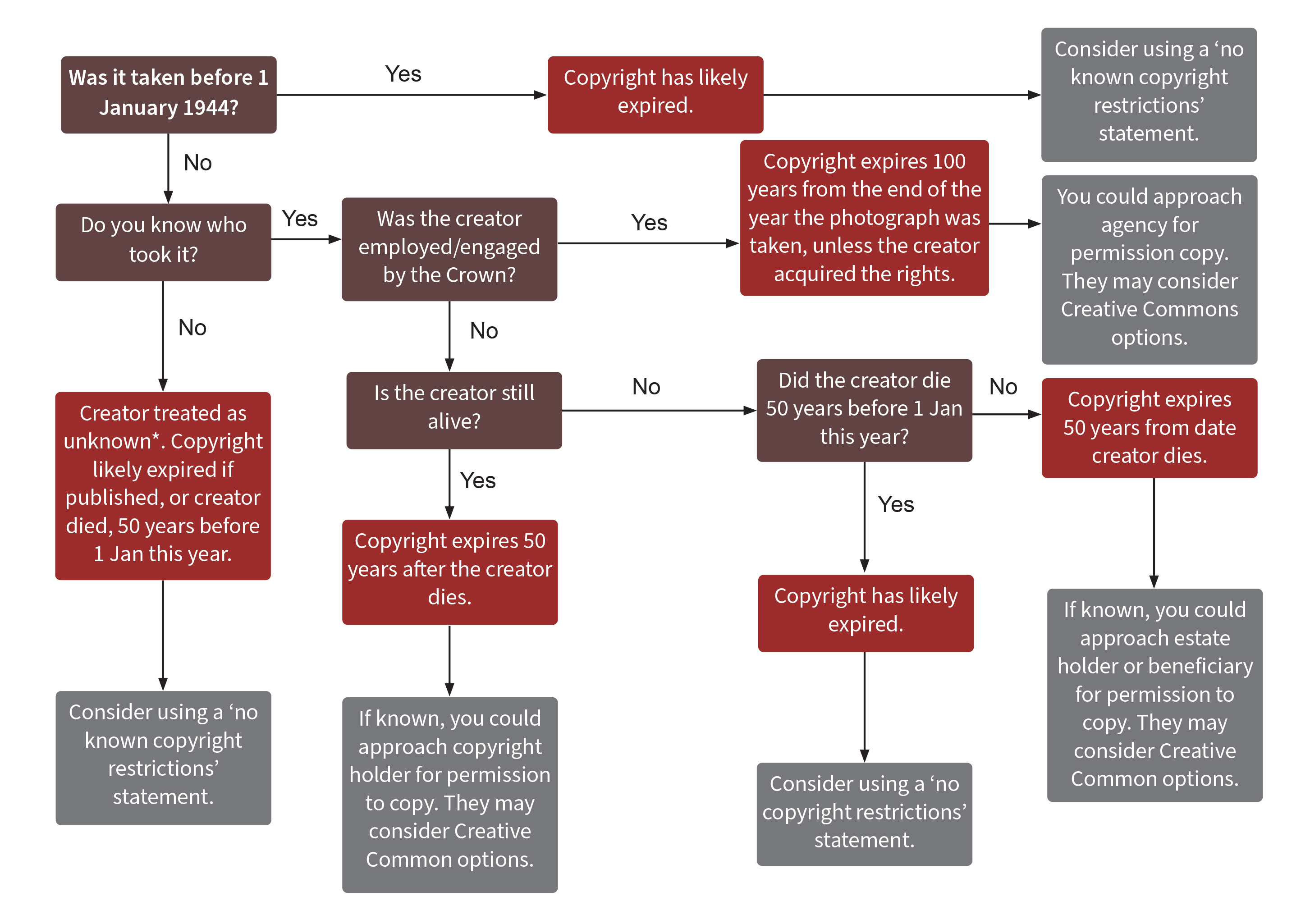Copyright status flowchart
DigitalNZ is proud to make available the NZ copyright status flowchart for determining the New Zealand copyright status of photographs.
Disclaimer: This flowchart is of a generalised nature, for information only. Nothing in this flowchart constitutes professional advice and DigitalNZ is not responsible for any loss caused as a result of using this flowchart. Users should seek professional advice from a suitably qualified professional about specific issues.

Notes on the NZ copyright status flowchart
Status changes: New information may change the copyright status – you could even use the web as an opportunity to find out this information, using appropriate disclaimers.
Conditions on use: If a photograph is out of copyright any conditions placed by the copyright owner on its use are no longer binding. However, you may decide to observe other conditions such as donor agreements or protocols around images of taonga Māori.
Privacy: Individuals have the right to privacy in photos taken for private and domestic purposes on or after 1 January 1995. Privacy rights last for the duration of the copyright term.
Fair dealing & educational use: You can make copies of in-copyright photos for certain things, such as criticism, review, research, private study, and education. See Sections 42-43 of the Copyright Act 1994.
Commissions & contracts: Keep in mind that people who commission photographers to take photos own the copyright in the work unless there is agreement otherwise. Refer to Section 21(3) and (4) of the Act. Contractors can also negotiate to own copyright instead of their employer. The Commissioning Rule is currently being reviewed and may change.
*Reasonable enquiry: Unknowns (such as assumptions about when a creator died or that a photographer is unknown) are subject to you making a ‘reasonable enquiry’, which you may have to defend.
Download the New Zealand copyright status flowchart for photographs (PDF/57.3 KB)
Why provide the NZ copyright status flowchart?
One of the problems that many content owners face is determining the New Zealand copyright status of items. If you can’t determine the copyright status of your content, you can’t accurately apply rights statements such as Creative Commons licences or ‘no known copyright restrictions’.
The information in this flowchart relates to copyright for photographs first published in New Zealand or taken by New Zealand citizens or residents.
The tool we’ve developed is intended to meet ‘80%’ or thereabouts of situations, rather than trying to provide a decision tree for every possible scenario (e.g. rights of joint photographers). These are things you need to take note of though.
Who’s the NZ copyright status flowchart for?
We think it will be useful to you if you are a New Zealand organisation or individual:
Working with photograph collections that you want to make available online
Trying to work out what the copyright status of a New Zealand photograph you find online might be, if it’s not already identified.
Has a lawyer looked at the NZ copyright status flowchart?
Yes, and then some. We’ve worked with a number of experts and lawyers to ensure that this flowchart is a useful tool for determining the copyright status of photographs. We also sought input from practitioners in the field before publishing this version.
That said, this flowchart is of a generalised nature, for information only. As the disclaimer states, it doesn’t constitute professional advice and DigitalNZ is not responsible for any loss caused as a result of using it. You should seek professional advice from a suitably qualified professional about specific issues. Don't let that put you off using it though!
Why is the starting date 1 January 1944?
The logic to the opening entry of the flowchart is that copyright in photographs taken prior to 1945 only received 50 years’ protection under the Copyright Act 1962. Copyright in any photograph taken 50 years before the Copyright Act 1994 commenced is therefore likely to have expired.
On legal advice, we have been cautious and changed the starting date to prior to 1 January 1944. Transitional provisions of the Copyright Act 1994 (clause 17 of the First Schedule) provide that the “life plus 50 rule” applies to photographs in which copyright subsisted immediately before the commencement (which was 1 January 1995).
As copyright in photographs taken in the year 1944 might not expire until 31 December 1994, there could be a legal argument that copyright subsisted immediately before (i.e. one day before) the commencement of the 1994 Act and so would enjoy the longer period of copyright protection.